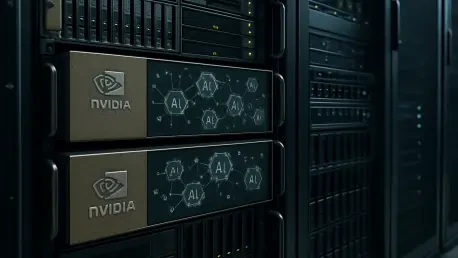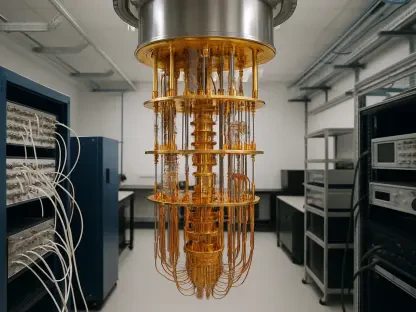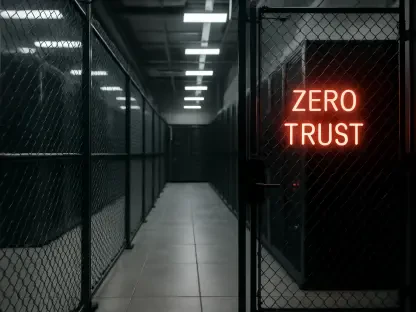In today’s ever-evolving world of artificial intelligence (AI), the need for computational power has reached unprecedented levels. With AI models growing in complexity and size, relying on a single data center for AI training is no longer a viable option. This is where multiple data centers, either co-located or geographically dispersed, step in to meet the demands of extensive AI workloads. Enter the NVIDIA Collective Communication Library (NCCL), which has recently introduced features to facilitate seamless communication across multiple data centers. By incorporating network topology awareness, NCCL promises enhanced performance and minimal disruptions in AI training workloads.
Exploring NCCL’s Multi-Data Center Capabilities
The integration of multiple data centers into AI training workflows presents unique challenges and opportunities. NCCL already supports multiple communicators, each utilizing distinct networks. For instance, in an all-reduce collective operation, the process can be segmented into an intra-data center reduce-scatter followed by an inter-data center all-reduce, and finally completing with an intra-data center all-gather. This methodology is particularly useful in optimizing operations like those in the NVIDIA Nemo framework.
The prime objective of NCCL’s Cross-Data Center feature is to ensure superior performance when interconnected across multiple data centers. This capability assures efficient communication with minimal adjustments to existing AI training protocols. When considering infrastructure, two common scenarios emerge: data centers linked via homogeneous networks, typically utilizing InfiniBand (IB) or RDMA over Converged Ethernet (RoCE), and data centers connected through heterogeneous networks with intra-DC using IB/RoCE and inter-DC utilizing TCP.
NCCL’s design embraces the specific requirements of each scenario, adjusting its operations to maximize efficacy. As AI models grow, the importance of a robust, adaptable communication framework becomes more evident, ensuring that data flow between centers is smooth and efficient.
Network Awareness with NCCL’s ncclNet API
A cornerstone of NCCL’s adaptability in multi-DC scenarios is its keen network topology awareness. When handling complex AI training tasks spread across multiple data centers, knowing the exact network layout and connectivity specifics is crucial. This insight is achieved through the ncclNet API. Each represented network is depicted as a virtual set of devices, and these devices interact with each other through the API. By considering devices on different networks as distinct entities, NCCL can better manage the nuances of interconnected systems.
To capitalize on multiple networks within NCCL, the system’s configuration needs a specific setting adjustment. Enabling “NCCL_ALLNET_ENABLE=1” allows NCCL to leverage all available network plugins for each communicator. This approach, while powerful, may disable other functionalities, like collNet. One intriguing element is the fabric ID, which provides detailed insights into network topology. By exchanging fabric IDs during initialization, NCCL gathers critical information to map out the network’s configuration dynamically. This capability enables NCCL to adapt its algorithms and protocols to ensure top-tier performance, enhancing training efficiency across various data center scales.
Tailoring Algorithms for Optimal Network Performance
The algorithms in NCCL are central to its ability to facilitate efficient data movement across intricate network landscapes. The library consists of three main algorithm families: Ring, Tree, and PAT. Each caters to specific communication patterns and collective operations. For cross-data center challenges, NCCL focuses intently on the Ring and Tree algorithms to manage more dispersed communication patterns efficiently.
The Ring algorithm rearranges computing ranks within each data center, ensuring minimal cross-DC connections. In networks with varied bandwidth capacities, this approach is bolstered by enabling scattering. This tactic divides network utilization across multiple nodes, alleviating bottlenecks typically imposed by a single inter-DC connection. For instance, in high-demand scenarios, scattering optimizes data flow by distributing the load evenly, significantly enhancing throughput and lowering system strain.
Parallel to the Ring algorithm, the Tree algorithm also ensures that inter-DC communication is minimized. By constructing trees that initially form within single data centers, the algorithm leverages empty slots to connect between centers efficiently. The tree structure achieves this with careful node allocation, ensuring a balanced load and streamlined data path. Such strategies are indispensable for maximizing AI training efficiency without compromising performance over intricate inter-DC links.
Performance Metrics and Optimization Parameters
Achieving peak efficiency for AI training workloads spanning multiple data centers is contingent on an in-depth understanding of network performance metrics. For NCCL, the most reliable indicators include pairwise connection quality, latency, and bandwidth restrictions. With the wide array of connections in play, settings such as “NCCL_SCATTER_XDC” and “NCCL_MIN/MAX_CTAS” control the distribution and number of utilized channels, optimizing network flow.
Several adjustable parameters influence NCCL’s behavior to harness the full potential of hardware capabilities. For latency-ridden IB/RoCE connections, the “NCCL_IB_QPS_PER_CONNECTION” setting can refine performance. Similarly, for TCP connections, parameters like “NCCL_NSOCKS_PERTHREAD” and “NCCL_SOCKET_NTHREADS” play crucial roles in matching parallel processing requirements. Buffer sizes and inlined data settings further refine data transmission, ensuring that each communication route is employed optimally, tailored to specific network conditions.
These refinements, while technical, address the multifaceted demands of modern AI applications, ensuring that communication overheads are minimized and providing a seamless operational experience for AI researchers and engineers.
Reflecting on NCCL’s Role in AI Advancements
In the rapidly advancing realm of artificial intelligence (AI), the demand for computational power has skyrocketed. AI models, growing both in complexity and size, require immense processing capabilities, making the use of a single data center for AI training increasingly impractical. To accommodate these demanding AI workloads, the solution lies in leveraging multiple data centers, which may be co-located or spread across various geographic locations. This approach allows for the distribution of tasks and the handling of complex AI models, ultimately optimizing performance and resource utilization.
The NVIDIA Collective Communication Library (NCCL) has made strides in enhancing this multi-data center approach by introducing features that enable seamless communication between distant data centers. One of the standout improvements is network topology awareness, which ensures efficient data transfer and synchronization between sites, regardless of physical separation. This innovation promises to significantly boost performance while minimizing disruptions during AI training tasks, providing a robust framework for handling vast datasets and intricate models that are typical in today’s AI landscape. As AI continues to evolve, such advancements are crucial in sustaining the pace of innovation and meeting the growing demands of technology.









